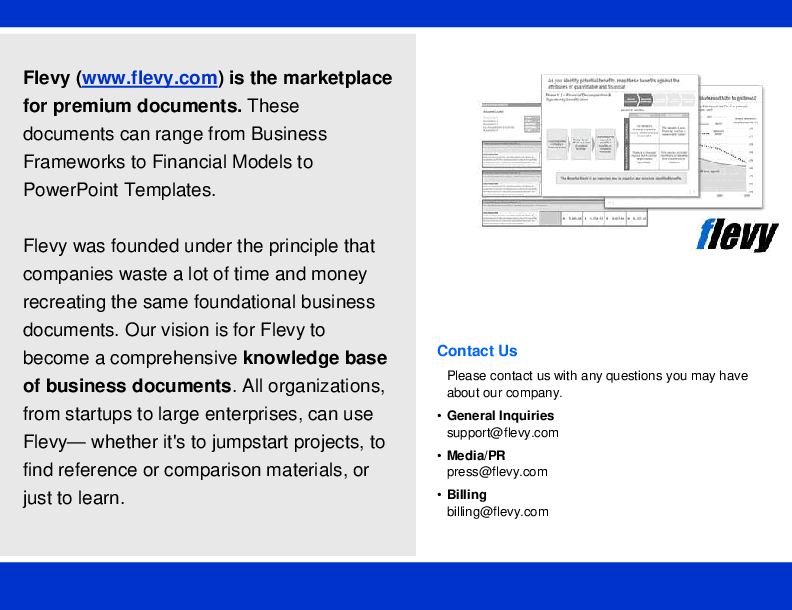Design for Six Sigma (DMADV) Poster (PDF)
PDF document + PowerPoint (PPTX) 7 Pages
BENEFITS OF DOCUMENT
- Provides a visual roadmap, simplifying complex design processes for easy reference and understanding.
- Serves as a comprehensive project documentation summary, aiding in effective project management and certification.
- Visually demonstrates how to seamlessly blend the DMADV methodology with Design Thinking, making the integration clear and actionable for users.
DESCRIPTION
DFSS, or Design for Six Sigma, represents a powerful approach solely dedicated to achieving superior quality and meeting customer expectations. This systematic methodology, presented in a structured DMADV (Define, Measure, Analyze, Design, Verify) format, equips organizations with the tools they need to craft superior products, processes, or services that align precisely with customer requirements and quality excellence.
DFSS is an invaluable resource for organizations navigating the ever-evolving landscape where customers demand top-notch quality, swift delivery, and minimal costs. It's not just a design method; it's a transformational engine that introduces fresh roles and practices within your organization, consistently yielding tangible results.
The DFSS Poster serves as your comprehensive guide to the five essential phases of process design and improvement, in line with the DFSS methodology. It simplifies the complex steps of DFSS, making it an indispensable reference for Six Sigma project teams tasked with project management and documentation for certification.
Available in two distinct designs—an engaging color scheme and a polished monochrome version—the poster is provided in both PDF and editable PPTX formats. This flexibility ensures effortless printing on standard A3/A4-sized paper from standard office equipment. Display it prominently at employee workstations or include it in your training materials for easy access.
Furthermore, the DFSS Poster complements your Six Sigma training presentation materials. It serves as a key takeaway and summarization of your process design and improvement training, reinforcing the principles and practices that are vital for achieving design excellence and customer satisfaction.
Blending DFSS with Design Thinking
The DMADV (Define, Measure, Analyze, Design, Verify) methodology of Design for Six Sigma (DFSS) and the five phases of Design Thinking (Empathize, Define, Ideate, Prototype, Test) can complement each other to create a holistic approach to product and process development. Here's how they can be blended in each of the DMADV phases:
1. Define Phase (DMADV):
Blend with Empathize (Design Thinking): During the "Define" phase of DMADV, integrate the Design Thinking "Empathize" phase by conducting extensive user research and empathy-building activities. Gain a deep understanding of user needs, preferences, and pain points to inform the definition of project goals and customer requirements.
2. Measure Phase (DMADV):
Blend with Define (Design Thinking): In the "Measure" phase, align the DMADV phase with the "Define" phase of Design Thinking. Clearly define the problem statement and project scope based on the insights gathered from empathetic understanding. Use tools like personas, journey mapping, and problem framing to guide the measurement of the current state.
3. Analyze Phase (DMADV):
Blend with Ideate (Design Thinking): While analyzing data in the DMADV phase, integrate the Design Thinking "Ideate" phase. Encourage cross-functional brainstorming sessions to ideate potential solutions and identify root causes creatively. This approach fosters innovative problem-solving.
4. Design Phase (DMADV):
Blend with Prototype (Design Thinking): During the "Design" phase, align with the Design Thinking "Prototype" phase. Develop and test design alternatives through rapid prototyping, considering user feedback. This iterative approach enhances the final design's alignment with user expectations.
5. Verify Phase (DMADV):
Blend with Test (Design Thinking): In the "Verify" phase, integrate the Design Thinking "Test" phase. Conduct usability testing, user validation, and feedback collection to ensure that the final design meets customer requirements and expectations. Make necessary adjustments based on user insights.
Blending DMADV with Design Thinking encourages a user-centered and iterative approach to product or process development. It ensures that user needs are at the forefront of the design process and that solutions are continuously refined and validated. This approach fosters innovation and collaboration within cross-functional teams, ultimately delivering high-quality results.
The DFSS Poster not only outlines the critical phases of the DMADV process, but also highlights key activities that drive effective project execution. This visual tool empowers teams to streamline their approach, ensuring clarity and focus on delivering high-quality outcomes that resonate with customer needs.
Got a question about the product? Email us at support@flevy.com or ask the author directly by using the "Ask the Author a Question" form. If you cannot view the preview above this document description, go here to view the large preview instead.
Source: Best Practices in Six Sigma Project, Six Sigma, Design for Six Sigma, DFSS PDF: Design for Six Sigma (DMADV) Poster PDF (PDF) Document, Operational Excellence Consulting





